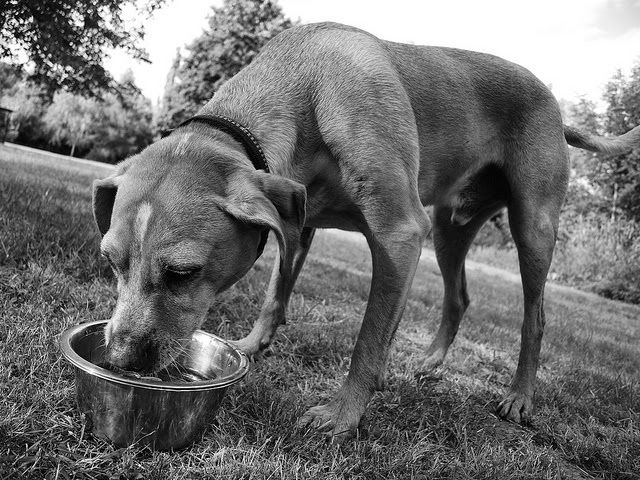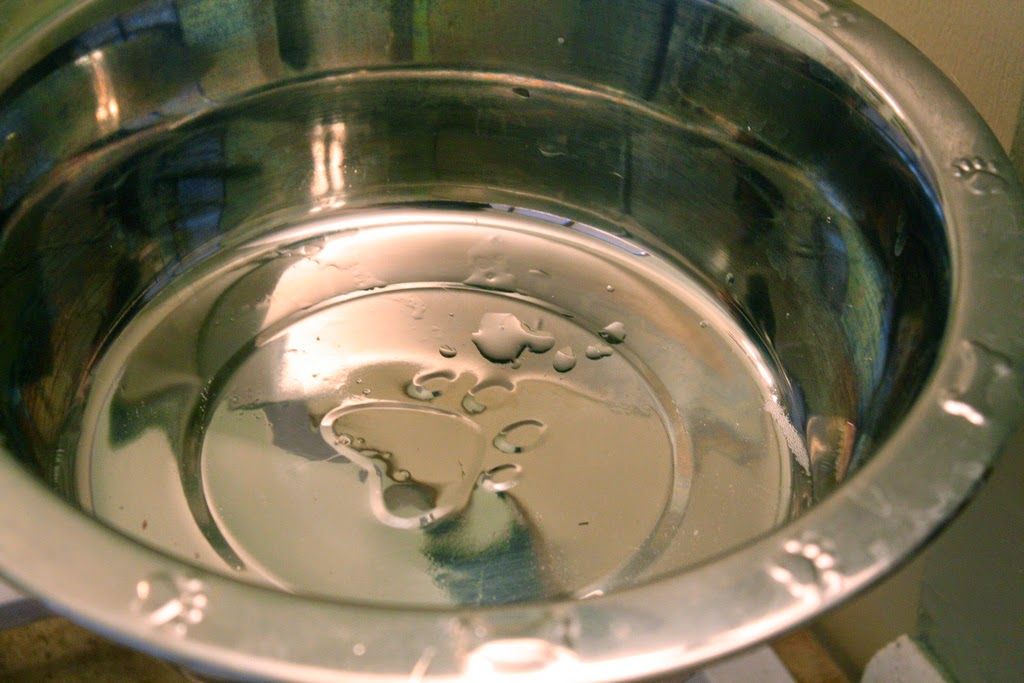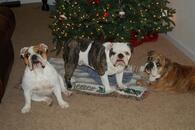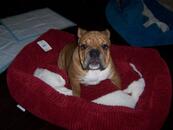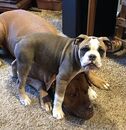[h=3]safe?[/h]
There are a wide variety of dog bowls on the market - plastic ones, slow down eating ones, silicon ones, stainless steel ones, ceramic ones, stoneware ones, and yes, even paper ones and ones made of sugar cane.
But how do you know if your dog bowl is safe?
We've done a bit of research on the different types of dog food bowls on the market...here's what we found:
Plastic
Some of the most popular dog bowls on the market are plastic. But unknown to many, they can be the most dangerous bowls with which to feed and water your pet! There are a couple of reasons for this:
One reason is that plastics scratch and those little crevices can harbor unhealthy bacteria, that even a good safe cleaning can't deter.
In addition, there are many reports in the news that plastics can emit chemicals like Bisphenal A, or BPA. Every few years, articles regarding the safety of plastics hit the news headlines – most recently in the form of reports of a chemical found in baby and sports bottles: Bisphenal A, or BPA.
What is BPA? The EWG says, "bisphenol a (BPA), a synthetic estrogen used to harden polycarbonate plastics and epoxy resin, is the focus of a growing number of research studies and legislative actions, reflecting mounting scientific evidence that it causes serious and sometimes irreversible damage to health, even at the low doses to which people are routinely exposed."
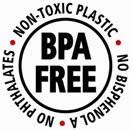 The Environmental Working Group also goes on to say..."in laboratory tests, trace BPA exposure has been shown to disrupt the endocrine system and trigger a wide variety of disorders, including chromosomal and reproductive system abnormalities, impaired brain and neurological functions, cancer, cardiovascular system damage, adult-onset diabetes, early puberty, obesity and resistance to chemotherapy." So if they are having this kind of effect on humans, imagine what they are doing to our little dog bodies!
The Environmental Working Group also goes on to say..."in laboratory tests, trace BPA exposure has been shown to disrupt the endocrine system and trigger a wide variety of disorders, including chromosomal and reproductive system abnormalities, impaired brain and neurological functions, cancer, cardiovascular system damage, adult-onset diabetes, early puberty, obesity and resistance to chemotherapy." So if they are having this kind of effect on humans, imagine what they are doing to our little dog bodies!
Plastics can also emit dangerous Phthalates, according to the EWG. "These chemicals, called “plasticizers,” are a group of industrial chemicals used to make plastics like polyvinyl chloride (PVC) more flexible or resilient and also as solvents. Phthalates are nearly ubiquitous in modern society, found in, among other things, toys, food packaging, hoses, raincoats, shower curtains, vinyl flooring, wall coverings, lubricants, adhesives, detergents, nail polish, hair spray and shampoo."
In addition, HealthyStuff.org, an organization who tests many pet products for levels of lead, chlorine, arsenic and more, indicates that even though some plastic pet bowls may be BPA free and certified as FDA food safe, some may contain medium levels of lead.
And these chemicals can leach from plastic containers into your dog's food, potentially exposing them to dangerous chemicals with harmful side affects.
There are some safe food plastics, and generally speaking most human plastics containers can beidentified by their recycling codes that can help you find the safe ones. But the pet industry is slow to add this helpful id tool to pet products, so we are left not knowing what plastic pet dish is safe and which is not, or taking the word of the manufacturer.
Yes, there are some safe plastic bowls, but how do you know for sure, without having them tested in a trusted lab?
Stoneware
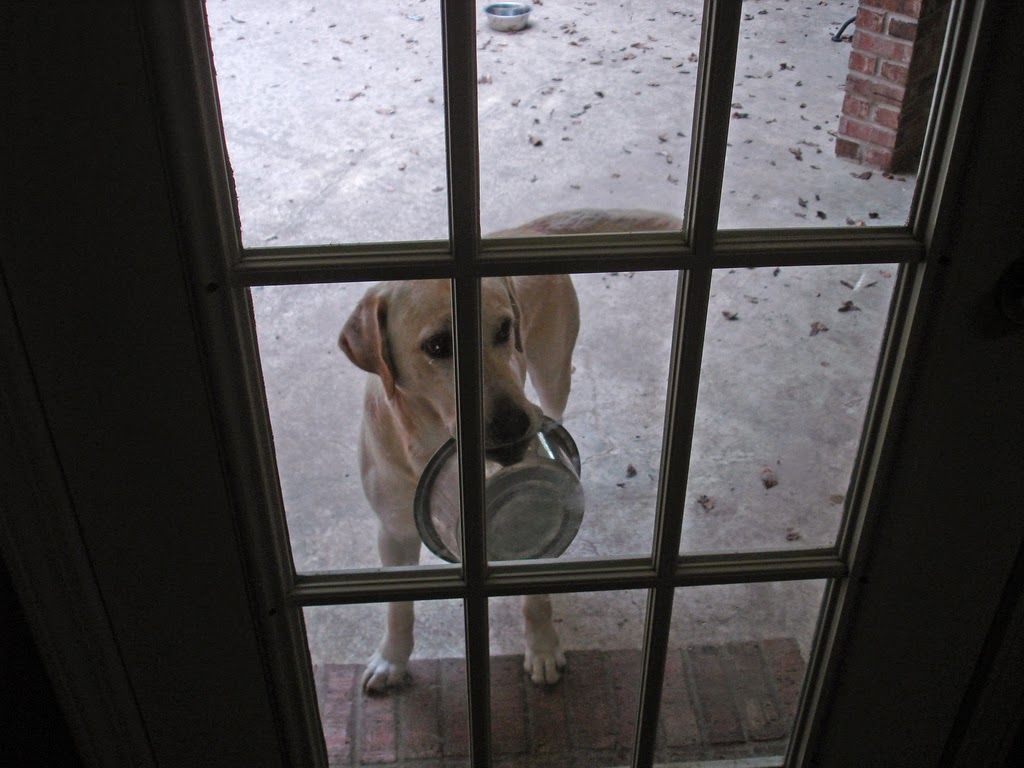 According to HealthyStuff.org some stoneware pet bowls may contain medium levels of dangerous lead that could be harmful to your dog.
According to HealthyStuff.org some stoneware pet bowls may contain medium levels of dangerous lead that could be harmful to your dog.
In 1973, the U.S. Environmental Protection Agency began phasing out leaded gasoline, a process that was to drag on until 1996. Lead was banned in household paint in 1978. As a result, according to the National Institute of Environmental Health Sciences, lead levels in the blood of American children have dropped by 86 percent since the late 1970s."
The EWG says..."the insidious symptoms of slow lead poisoning -- impaired intellect, memory loss, mood swings, infertility, nerve, joint and muscle disorders, cardiovascular, skeletal, kidney and renal problems and possibly cancer -- were not fully recognized until the late 20th century.
Some manufacturers tout their stoneware bowls as lead free. But, while HealthStuff.org is sharing a lot of research about stoneware pet bowls, they have yet to test every bowl on the market. So why potentially expose your dog to such a dangerous chemical?
Silicone
Lately we've been seeing several silicone based pet food bowls hit the market. While they are deemed made of FDA approved food based silicone, we are with the the 'jury is still out,' pack on this new method of feeding.
According to Wikipedia, silicones are largely-inert, man-made compounds with a wide variety of forms and uses. Typically heat-resistant, nonstick, and rubber-like, they are commonly used in cookware, medical applications, sealants, adhesives, lubricants, insulation, and breast implants.
Over the years, we've read about the problems women have had with silicone breast implants, (the same stuff used to create food safe silicone bowls). So many dangers have been found with the various methods we use for feeding, that I'm of the 'better safe than sorry" set. Time will tell...
Ceramic
Many ceramic dog bowls can be a good choice if you do your homework and select carefully. Some glazes used to coat the dog bowl could contain lead and other chemicals.
So if you decide to use a ceramic bowl make certain it is intended for food use and that it is coated with a lead free glaze. And also be certain to check the bowl often for little cracks in the glaze, that can not only harbor bacteria, but can also potentially be ingested if cracked or chipped.
Sugar Cane and Corn
Many disposable pet bowls made of sugar cane and corn are hitting the market. Patterned after human disposable paper plates and made from sugar cane or corn, these pet bowls are touted as being very eco-friendly and green, as well as safe for dogs. Many say after several uses, you can put them into your compost pile to biodegrade, which would cut down on added waste to landfills, and the inability to actually biodegrade when buried under all that trash at the landfill.
Since sugar cane and corn in very low ingestion levels is not toxic or dangerous for dogs, we feel these dishes would be a nice emergency or travel option for dogs. We would keep a watchful eye on my sis, Gracie, however, since she would perhaps be apt to eat something like a bowl made of sugar cane...she's like that you know And we know that anything like this in large proportions wouldn't be good for her intestinal tract.
And we know that anything like this in large proportions wouldn't be good for her intestinal tract.
Stainless Steel
Over many years, stainless steel has be proven to be the safest material for making and storing foods. It is durable, sanitary, rust-free, and non-leaching. And the best part is that they can last a lifetime, and save you money! In their tips to avoid certain chemical exposure, the EWG recommendsin many instances to replace non-safe plastics with stainless steel.
What we use!
So what's a dog to do? We recommend going stainless steel. It is widely believed to be one of the safest dog food and water dispensing bowls. It's what we use for all our meals and water, whether at home or on the road, for us pups and our kittie bros.
You can purchase many sizes and types of stainless steel dog bowls, including slow down eating and non-skid, small or gigantic!
Properly cared for stainless steel pet bowls won't harbor dangerous bacteria, and they don't emit dangerous chemicals.
Be sure to clean your stainless steel bowl after every use to ward off potential illness from bacteria, and don't clean it with any abrasive material like steel wool. Just use a safe eco-friendly dish soap and hot water, or better yet, do what we do, clean with a nice mixture of vinegar and water.
Update: Please be sure to inquire at your pet store if your stainless steel pet bowls are radioactive and lead free, as reports have been made that some stainless steel pet bowls may contain low levels of lead and radiation. See more information below to learn more.
Oh, and watch what you store your pets food in as well! There are many, many pet storage containers made of plastic, but we are happy to see stainless steel and jute pet food storage containers hitting the market as well. Watch for resource links in our next post.
There are a wide variety of dog bowls on the market - plastic ones, slow down eating ones, silicon ones, stainless steel ones, ceramic ones, stoneware ones, and yes, even paper ones and ones made of sugar cane.
But how do you know if your dog bowl is safe?
We've done a bit of research on the different types of dog food bowls on the market...here's what we found:
Plastic
Some of the most popular dog bowls on the market are plastic. But unknown to many, they can be the most dangerous bowls with which to feed and water your pet! There are a couple of reasons for this:
One reason is that plastics scratch and those little crevices can harbor unhealthy bacteria, that even a good safe cleaning can't deter.
In addition, there are many reports in the news that plastics can emit chemicals like Bisphenal A, or BPA. Every few years, articles regarding the safety of plastics hit the news headlines – most recently in the form of reports of a chemical found in baby and sports bottles: Bisphenal A, or BPA.
What is BPA? The EWG says, "bisphenol a (BPA), a synthetic estrogen used to harden polycarbonate plastics and epoxy resin, is the focus of a growing number of research studies and legislative actions, reflecting mounting scientific evidence that it causes serious and sometimes irreversible damage to health, even at the low doses to which people are routinely exposed."
 The Environmental Working Group also goes on to say..."in laboratory tests, trace BPA exposure has been shown to disrupt the endocrine system and trigger a wide variety of disorders, including chromosomal and reproductive system abnormalities, impaired brain and neurological functions, cancer, cardiovascular system damage, adult-onset diabetes, early puberty, obesity and resistance to chemotherapy." So if they are having this kind of effect on humans, imagine what they are doing to our little dog bodies!
The Environmental Working Group also goes on to say..."in laboratory tests, trace BPA exposure has been shown to disrupt the endocrine system and trigger a wide variety of disorders, including chromosomal and reproductive system abnormalities, impaired brain and neurological functions, cancer, cardiovascular system damage, adult-onset diabetes, early puberty, obesity and resistance to chemotherapy." So if they are having this kind of effect on humans, imagine what they are doing to our little dog bodies! Plastics can also emit dangerous Phthalates, according to the EWG. "These chemicals, called “plasticizers,” are a group of industrial chemicals used to make plastics like polyvinyl chloride (PVC) more flexible or resilient and also as solvents. Phthalates are nearly ubiquitous in modern society, found in, among other things, toys, food packaging, hoses, raincoats, shower curtains, vinyl flooring, wall coverings, lubricants, adhesives, detergents, nail polish, hair spray and shampoo."
In addition, HealthyStuff.org, an organization who tests many pet products for levels of lead, chlorine, arsenic and more, indicates that even though some plastic pet bowls may be BPA free and certified as FDA food safe, some may contain medium levels of lead.
And these chemicals can leach from plastic containers into your dog's food, potentially exposing them to dangerous chemicals with harmful side affects.
There are some safe food plastics, and generally speaking most human plastics containers can beidentified by their recycling codes that can help you find the safe ones. But the pet industry is slow to add this helpful id tool to pet products, so we are left not knowing what plastic pet dish is safe and which is not, or taking the word of the manufacturer.
Yes, there are some safe plastic bowls, but how do you know for sure, without having them tested in a trusted lab?
Stoneware
 According to HealthyStuff.org some stoneware pet bowls may contain medium levels of dangerous lead that could be harmful to your dog.
According to HealthyStuff.org some stoneware pet bowls may contain medium levels of dangerous lead that could be harmful to your dog.In 1973, the U.S. Environmental Protection Agency began phasing out leaded gasoline, a process that was to drag on until 1996. Lead was banned in household paint in 1978. As a result, according to the National Institute of Environmental Health Sciences, lead levels in the blood of American children have dropped by 86 percent since the late 1970s."
The EWG says..."the insidious symptoms of slow lead poisoning -- impaired intellect, memory loss, mood swings, infertility, nerve, joint and muscle disorders, cardiovascular, skeletal, kidney and renal problems and possibly cancer -- were not fully recognized until the late 20th century.
Some manufacturers tout their stoneware bowls as lead free. But, while HealthStuff.org is sharing a lot of research about stoneware pet bowls, they have yet to test every bowl on the market. So why potentially expose your dog to such a dangerous chemical?
Silicone
Lately we've been seeing several silicone based pet food bowls hit the market. While they are deemed made of FDA approved food based silicone, we are with the the 'jury is still out,' pack on this new method of feeding.
According to Wikipedia, silicones are largely-inert, man-made compounds with a wide variety of forms and uses. Typically heat-resistant, nonstick, and rubber-like, they are commonly used in cookware, medical applications, sealants, adhesives, lubricants, insulation, and breast implants.
Over the years, we've read about the problems women have had with silicone breast implants, (the same stuff used to create food safe silicone bowls). So many dangers have been found with the various methods we use for feeding, that I'm of the 'better safe than sorry" set. Time will tell...
Ceramic
Many ceramic dog bowls can be a good choice if you do your homework and select carefully. Some glazes used to coat the dog bowl could contain lead and other chemicals.
So if you decide to use a ceramic bowl make certain it is intended for food use and that it is coated with a lead free glaze. And also be certain to check the bowl often for little cracks in the glaze, that can not only harbor bacteria, but can also potentially be ingested if cracked or chipped.
Sugar Cane and Corn
Many disposable pet bowls made of sugar cane and corn are hitting the market. Patterned after human disposable paper plates and made from sugar cane or corn, these pet bowls are touted as being very eco-friendly and green, as well as safe for dogs. Many say after several uses, you can put them into your compost pile to biodegrade, which would cut down on added waste to landfills, and the inability to actually biodegrade when buried under all that trash at the landfill.
Since sugar cane and corn in very low ingestion levels is not toxic or dangerous for dogs, we feel these dishes would be a nice emergency or travel option for dogs. We would keep a watchful eye on my sis, Gracie, however, since she would perhaps be apt to eat something like a bowl made of sugar cane...she's like that you know
 And we know that anything like this in large proportions wouldn't be good for her intestinal tract.
And we know that anything like this in large proportions wouldn't be good for her intestinal tract.Stainless Steel
Over many years, stainless steel has be proven to be the safest material for making and storing foods. It is durable, sanitary, rust-free, and non-leaching. And the best part is that they can last a lifetime, and save you money! In their tips to avoid certain chemical exposure, the EWG recommendsin many instances to replace non-safe plastics with stainless steel.
What we use!
So what's a dog to do? We recommend going stainless steel. It is widely believed to be one of the safest dog food and water dispensing bowls. It's what we use for all our meals and water, whether at home or on the road, for us pups and our kittie bros.
You can purchase many sizes and types of stainless steel dog bowls, including slow down eating and non-skid, small or gigantic!
Properly cared for stainless steel pet bowls won't harbor dangerous bacteria, and they don't emit dangerous chemicals.
Be sure to clean your stainless steel bowl after every use to ward off potential illness from bacteria, and don't clean it with any abrasive material like steel wool. Just use a safe eco-friendly dish soap and hot water, or better yet, do what we do, clean with a nice mixture of vinegar and water.
Update: Please be sure to inquire at your pet store if your stainless steel pet bowls are radioactive and lead free, as reports have been made that some stainless steel pet bowls may contain low levels of lead and radiation. See more information below to learn more.
Oh, and watch what you store your pets food in as well! There are many, many pet storage containers made of plastic, but we are happy to see stainless steel and jute pet food storage containers hitting the market as well. Watch for resource links in our next post.
